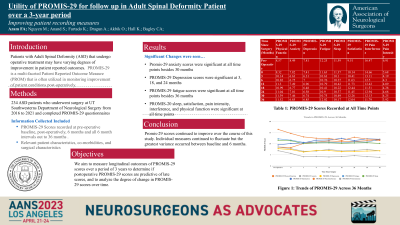Utility of PROMIS-29 for follow up in Adult Spinal Deformity Patient over a 3-year period
Utility of PROMIS-29 for Follow up in Adult Spinal Deformity Patient over a 3-year Period
Friday, April 21, 2023


Faraaz A. Azam (he/him/his)
Medical Student
UT Southwestern Medical Center
ePoster Presenter(s)
Introduction: Patients with Adult Spinal Deformity (ASD) that undergo operative treatment may have varying degrees of improvement in patient reported outcomes. We aim to measure outcomes of PROMIS-29 scores over a period of 3 years to determine if postoperative PROMIS-29 scores are predictive of late scores, and to analyze the degree of change in PROMIS-29 scores over time.
Methods: 234 patients who underwent surgery for ASD at a large medical center from 2016 to 2021 and completed PROMIS-29 questionnaires met inclusion criteria. PROMIS-29 scores from follow-ups within +/-1 month of post-op, 6, 12, 18, 24, 30, and 36 months were included. Percent changes were recorded independently; significance was analyzed by t-tests.
Results: Promis-29 anxiety scores were significant at at all points besides 30 months (p=0.0003,p < 0.0001,p=0.0270,p=0.0005,p 0.0042,p=0.0063 respectively). Promis-29 depression scores were significantly different at 3, 18, and 24 months (p=0.0043,p=0.0075,p=0.0179 respectively). Promis-29 fatigue scores were significantly different at at all points besides 36 months (p=0.0092,p= 0.0053,p= 0.0059 p=0.0021,p= 0.0310,p=0.0215 respectively). Promise-29 sleep scores were significantly different at all time points (p= 0.0092,p= 0.0155,p= 0.0214,p= 0.0129, p= 0.0368,p= 0.0372 respectively). Promis-29 satisfaction scores were significantly different at 6, 12, 18, 24, 30, 36 months (p= 0.0006,p= 0.0005,p= 0.0001,p= 0.0057,p= 0.0004,p= 0.0025 respectively). Promis-29 pain interference scores were significantly differently at all recorded time points (p < 0.0001,p < 0.0001,p < 0.0001,p < 0.0001,p < 0.0001,p < 0.0001 respectively). Promis-29 pain intensity scores were significantly different at all recorded time points (p < 0.0001,p < 0.0001,p < 0.0001,p < 0.0001,p < 0.0001,p < 0.0001 respectively). Promis-29 physical function scores were significantly different at all time points (p=0.0025,p < 0.0001,p < 0.0001,p < 0.0001,p < 0.0001,p < 0.0001 respectively).
Conclusion : Promis-29 scores continued to improve over the course of this study. Individual measures continued to fluctuate but the greatest variance occurred between baseline and 6 months. With scores continuing to show significant changes out till 36 months, long term follow-up is indicated.
Methods: 234 patients who underwent surgery for ASD at a large medical center from 2016 to 2021 and completed PROMIS-29 questionnaires met inclusion criteria. PROMIS-29 scores from follow-ups within +/-1 month of post-op, 6, 12, 18, 24, 30, and 36 months were included. Percent changes were recorded independently; significance was analyzed by t-tests.
Results: Promis-29 anxiety scores were significant at at all points besides 30 months (p=0.0003,p < 0.0001,p=0.0270,p=0.0005,p 0.0042,p=0.0063 respectively). Promis-29 depression scores were significantly different at 3, 18, and 24 months (p=0.0043,p=0.0075,p=0.0179 respectively). Promis-29 fatigue scores were significantly different at at all points besides 36 months (p=0.0092,p= 0.0053,p= 0.0059 p=0.0021,p= 0.0310,p=0.0215 respectively). Promise-29 sleep scores were significantly different at all time points (p= 0.0092,p= 0.0155,p= 0.0214,p= 0.0129, p= 0.0368,p= 0.0372 respectively). Promis-29 satisfaction scores were significantly different at 6, 12, 18, 24, 30, 36 months (p= 0.0006,p= 0.0005,p= 0.0001,p= 0.0057,p= 0.0004,p= 0.0025 respectively). Promis-29 pain interference scores were significantly differently at all recorded time points (p < 0.0001,p < 0.0001,p < 0.0001,p < 0.0001,p < 0.0001,p < 0.0001 respectively). Promis-29 pain intensity scores were significantly different at all recorded time points (p < 0.0001,p < 0.0001,p < 0.0001,p < 0.0001,p < 0.0001,p < 0.0001 respectively). Promis-29 physical function scores were significantly different at all time points (p=0.0025,p < 0.0001,p < 0.0001,p < 0.0001,p < 0.0001,p < 0.0001 respectively).
Conclusion : Promis-29 scores continued to improve over the course of this study. Individual measures continued to fluctuate but the greatest variance occurred between baseline and 6 months. With scores continuing to show significant changes out till 36 months, long term follow-up is indicated.
